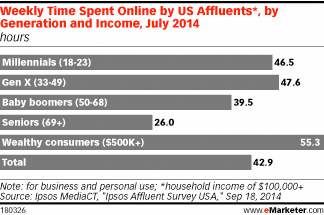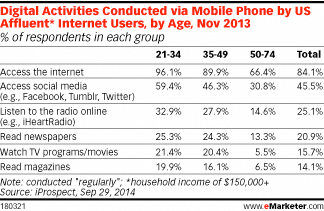Affluents not Monolithic in Media Consumption Habits
November 7, 2014
![]() The US affluent population is growing. At the same time, digital device usage by this demographic to access media is increasing, and they own these devices at a higher rate than the general population, according to a new eMarketer report, “US Affluents’ Media and Device Usage: Avidly Accessing Media, High Digital Device Ownership Drives Usage Higher.”
The US affluent population is growing. At the same time, digital device usage by this demographic to access media is increasing, and they own these devices at a higher rate than the general population, according to a new eMarketer report, “US Affluents’ Media and Device Usage: Avidly Accessing Media, High Digital Device Ownership Drives Usage Higher.”
 Given this high digital usage, it would seem to make sense for marketers who want to reach this demographic to be allocating their entire ad budget to digital. But it’s more complicated than that. Affluents’ engagement with traditional media also remains high. While readership of print media—newspapers and magazines—has fallen off precipitously over the past several years among the general population, engagement among affluents has remained steady. But income alone does not create a monolith. Spread as they are among millennials, Gen Xers, baby boomers and seniors, affluents’ media consumption habits are quite diverse.
Given this high digital usage, it would seem to make sense for marketers who want to reach this demographic to be allocating their entire ad budget to digital. But it’s more complicated than that. Affluents’ engagement with traditional media also remains high. While readership of print media—newspapers and magazines—has fallen off precipitously over the past several years among the general population, engagement among affluents has remained steady. But income alone does not create a monolith. Spread as they are among millennials, Gen Xers, baby boomers and seniors, affluents’ media consumption habits are quite diverse.
 In general, they are using digital devices to go online for long periods each week. Ipsos MediaCT found that on average, those with household incomes of $100,000 or more spent 42.9 hours per week online. Use was both business and personal, which may account for the fact that Gen Xers were slightly ahead of millennials in their time spent online (they may be spending more time online at work). And the wealthy—those with household incomes of $500,000 or more—spent more time online than any age group.
In general, they are using digital devices to go online for long periods each week. Ipsos MediaCT found that on average, those with household incomes of $100,000 or more spent 42.9 hours per week online. Use was both business and personal, which may account for the fact that Gen Xers were slightly ahead of millennials in their time spent online (they may be spending more time online at work). And the wealthy—those with household incomes of $500,000 or more—spent more time online than any age group.
Households with incomes of $100,000-plus are the largest demographic of tablet and smartphone users. According to July 2014 data from comScore, one-third of tablet users and nearly one-third of mobile users have incomes of $100,000 or more.
The big surprise in affluents’ media usage is the way older and younger age groups access media. As part of iProspect’s survey of affluents, the firm examined what types of media people are accessing on their devices and found that on mobile phones millennials (ages 21-34) and Gen Xers (ages 35-49) are accessing media at about the same rates. Newspapers are being read on smartphones by 25.3% of millennial affluents, while 24.3% of Gen Xers access newspapers that way. For boomers (ages 50-74), by contrast, the percentage drops to nearly half: 13.3% of boomers access newspapers via mobile phones.
Not only are affluents accessing traditional media via digital, they are paying for the privilege. Andrea Wilson, vice president, strategy director and luxury practice lead at iProspect, noted that its research showed millennials were the group most willing to pay for online news. “Millennials are consuming at every single outlet they can,” she said. “It’s not a narrow selection, but a robust selection that includes paper media as well as digital.”
Courtesy of eMarketer




























